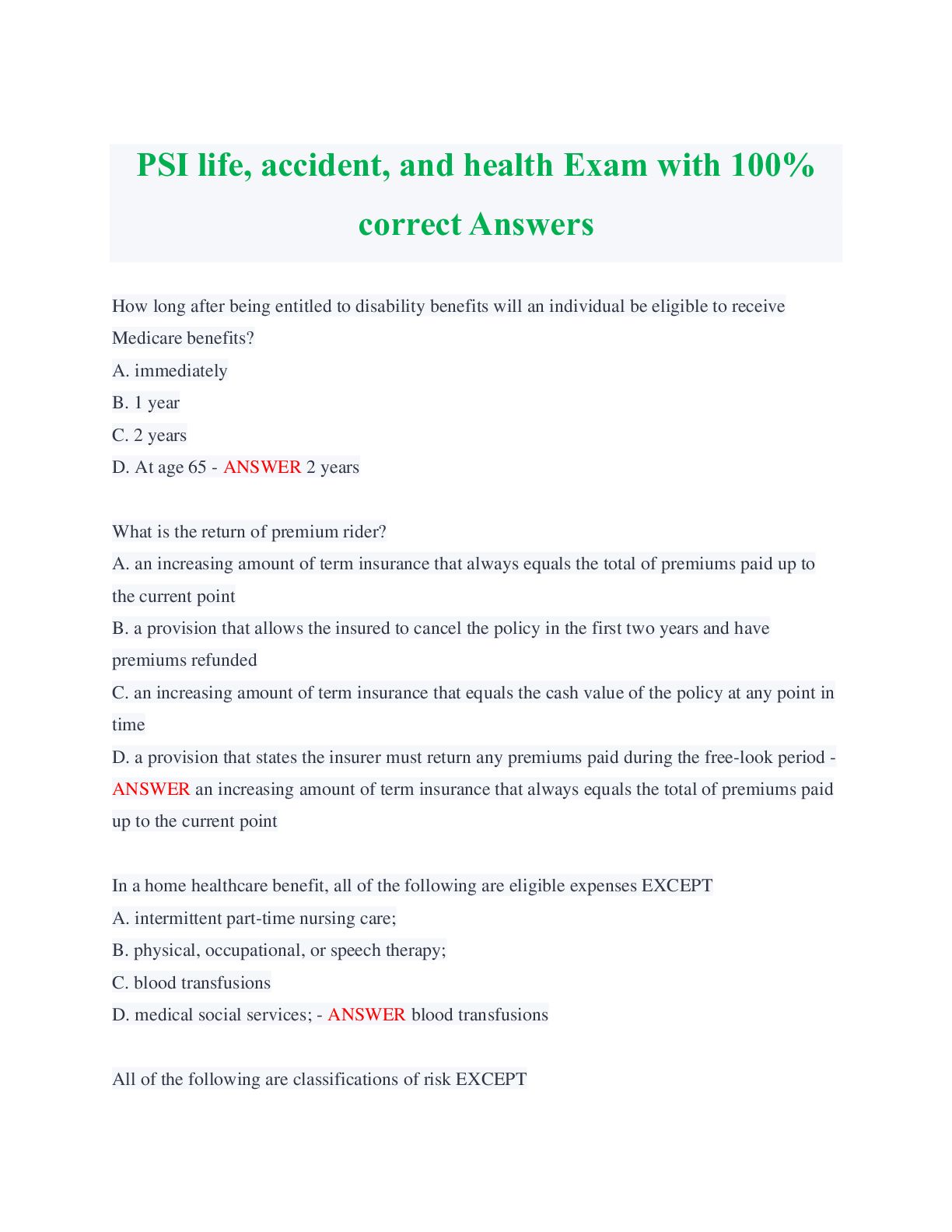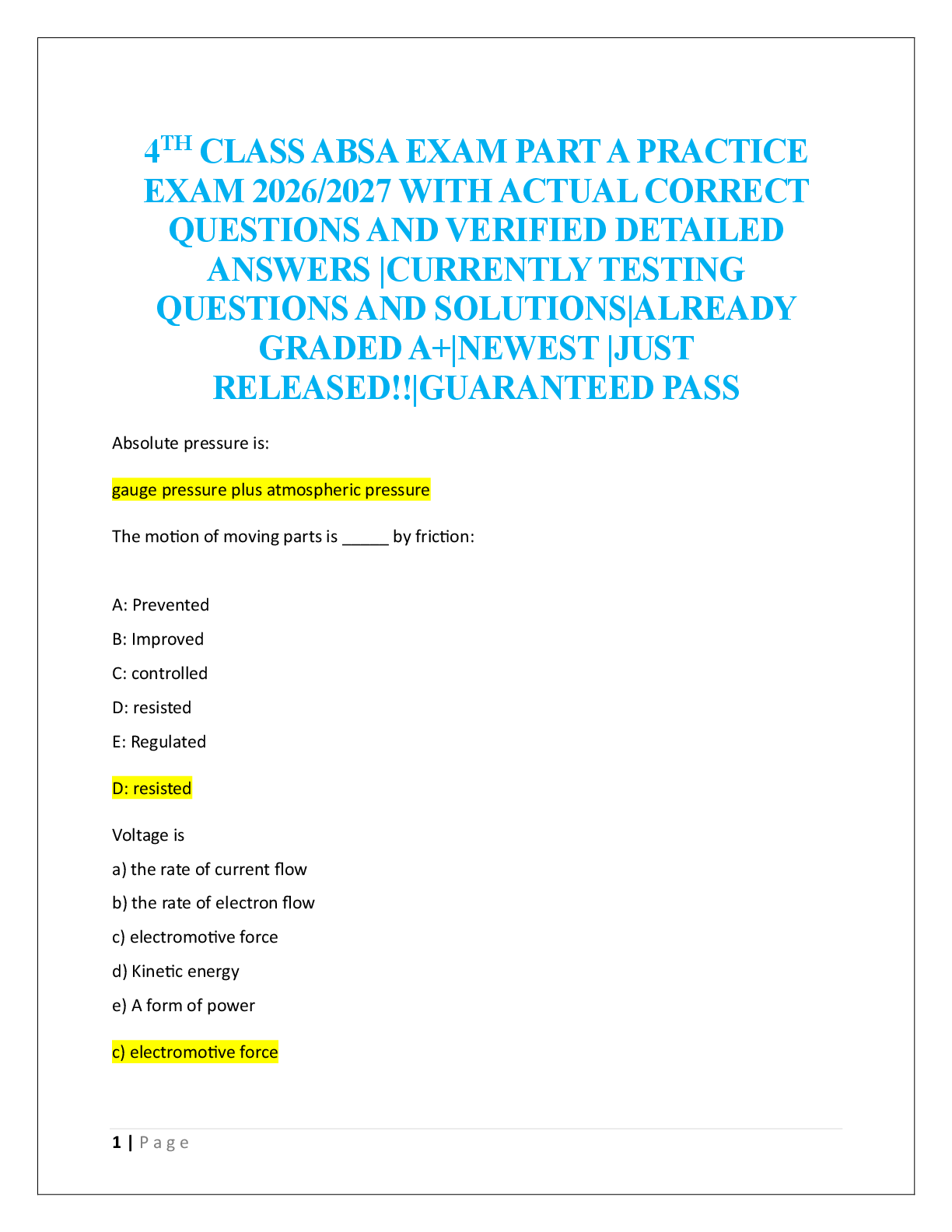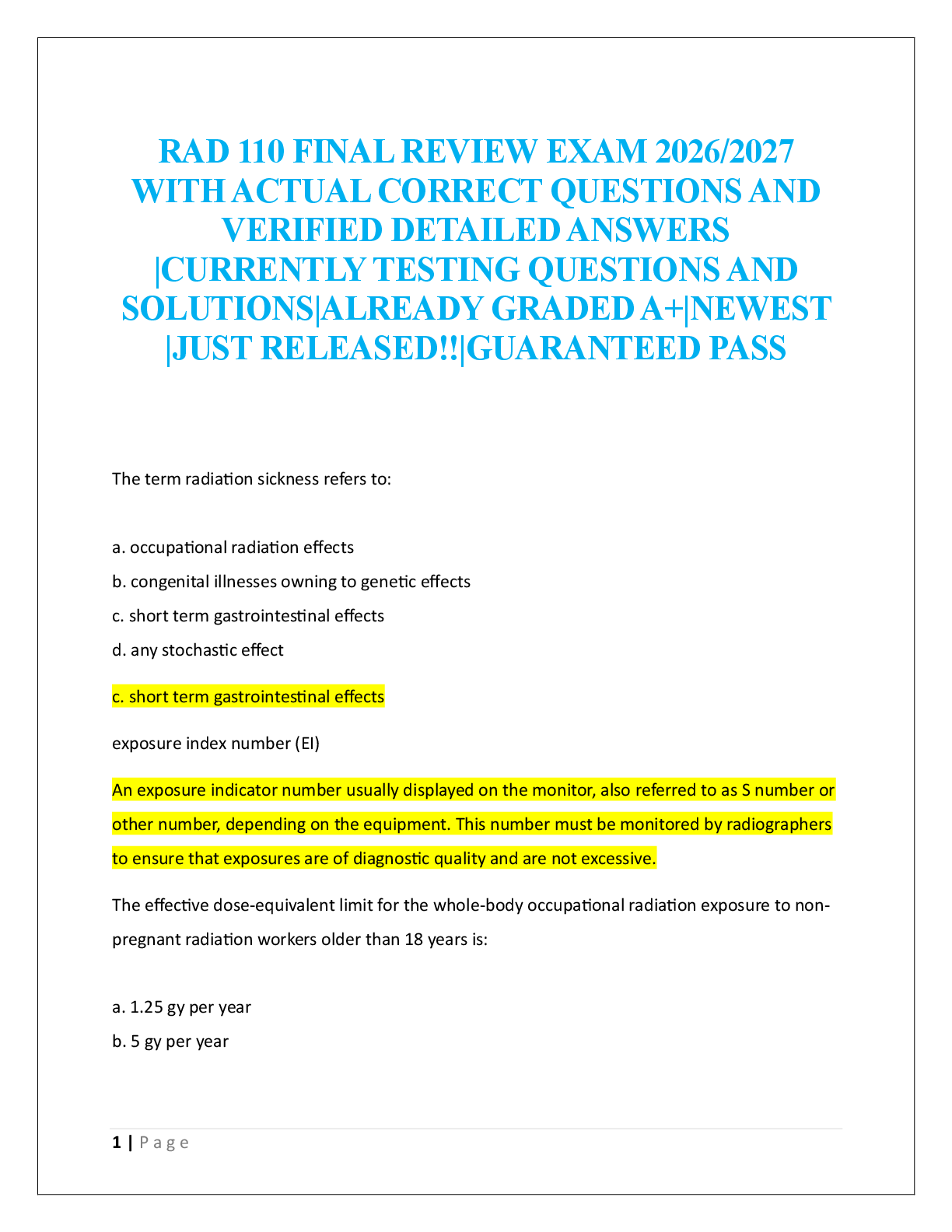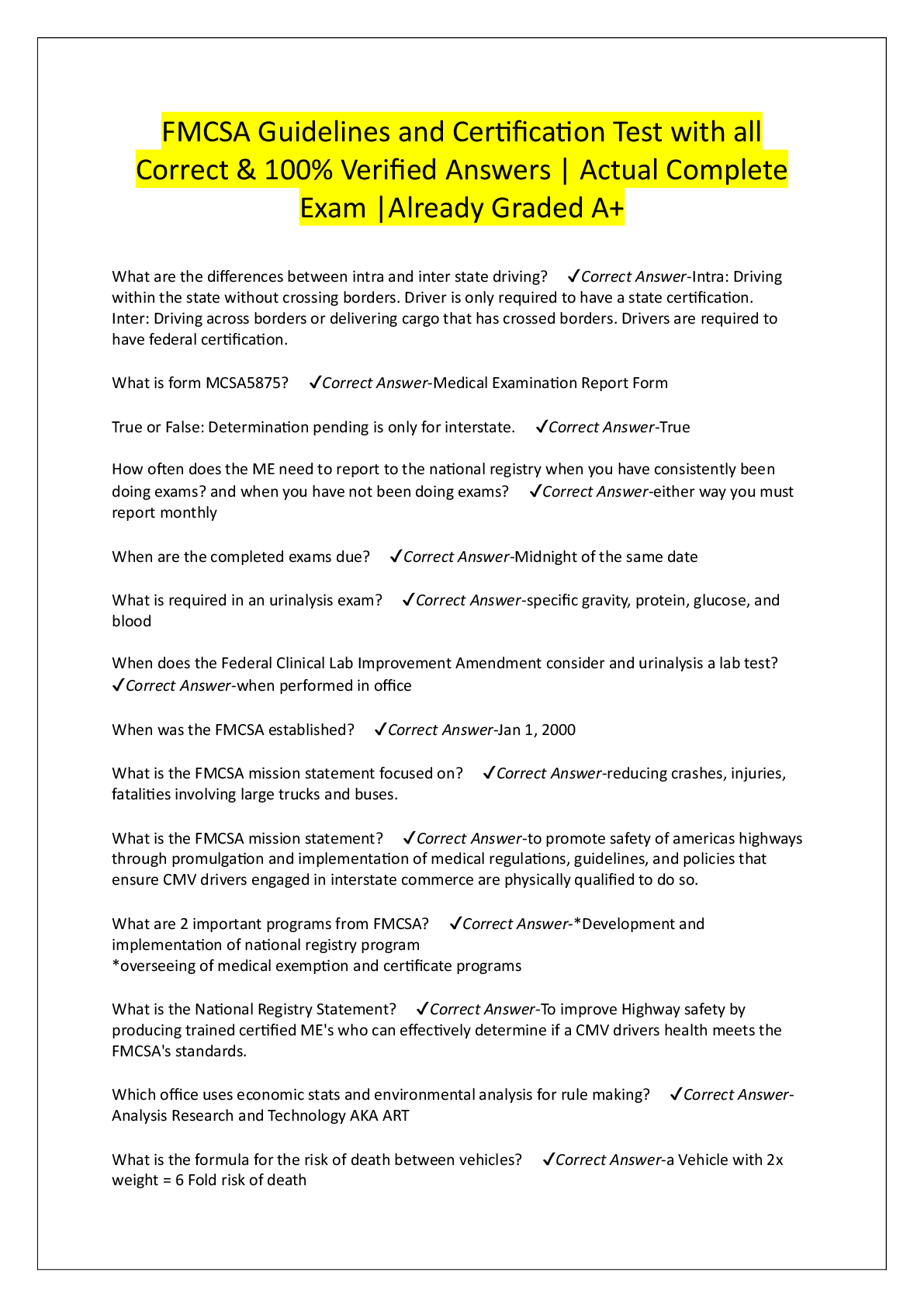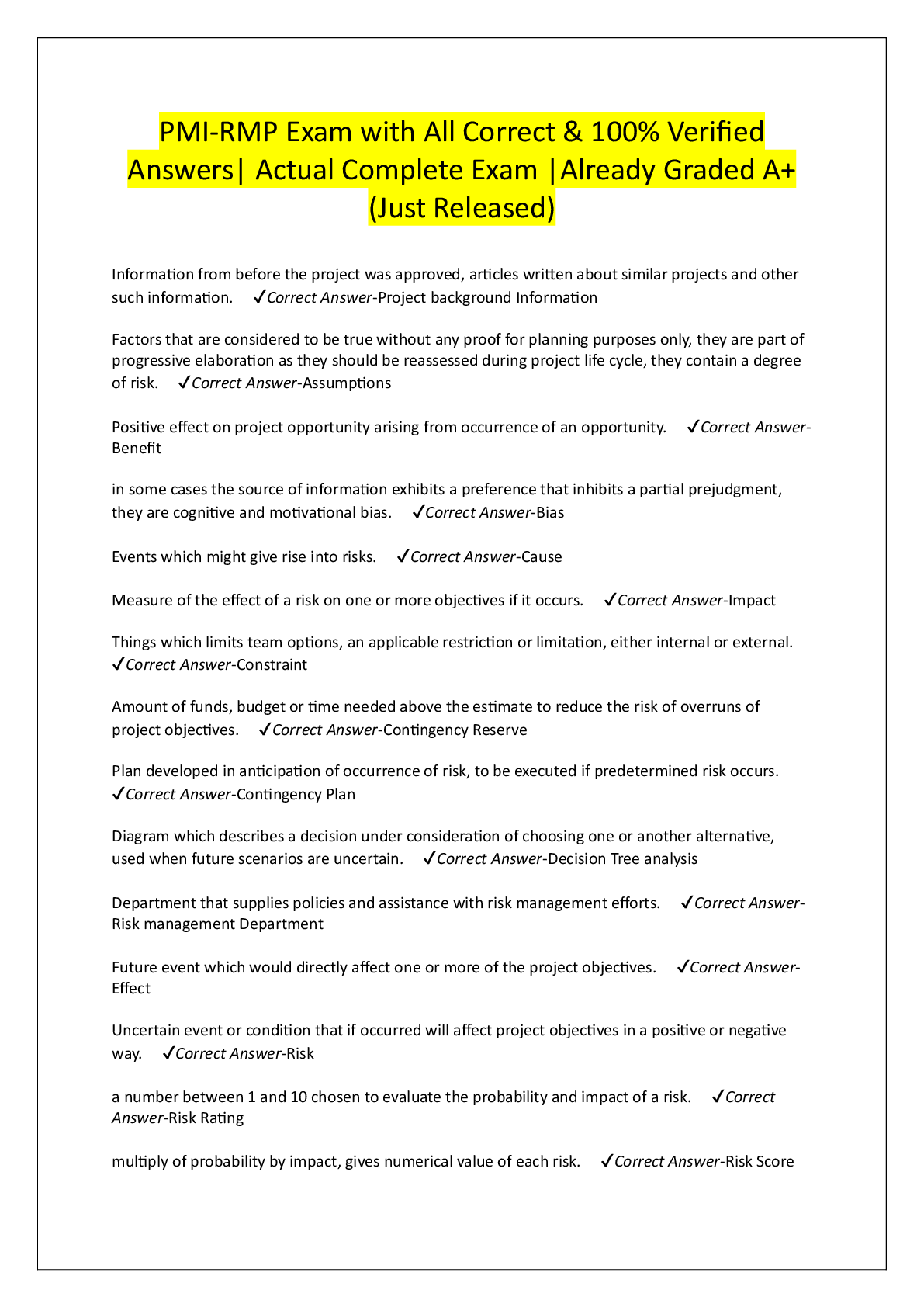Engineering > EXAM > Materials Engineering Exam Questions and Answers 2022/2023 (All)
Materials Engineering Exam Questions and Answers 2022/2023
Document Content and Description Below
Materials Engineering - ANSWER the understanding and modification of the structure and properties of materials to improve the performance and processing of the material Materials Science - ANSWER r ... esearch and explore new materials and their properties American Society for Testing and Materials (ASTM) - ANSWER Develops material testing standards, over 30,000 members worldwide Professional Materials Engineering Organizations - ANSWER -Materials Information Society -Materials Research Society -NACE International -Other organizations for ceramics, plastics, and metals Material Types - ANSWER Metals, Ceramics, Polymers, and Composites Metals - ANSWER -Most common element -Have crystalline atomic structure -High material strength -Good conductors of heat and electricity -Malleable (bends without breaking) -Inorganic -Most pure metals are natural Ore - ANSWER A mixture that requires processing to purify the metal / remove unwanted minerals Alloy - ANSWER -Metal mixed with one of more elements -Example: Brass = Copper + Zinc -Materials Engineers change the properties of alloys by changing the amount of individual elements that are used Ceramics - ANSWER -Nonmetallic solids made from inorganic materials -Made using a process of mixing, shaping, heating and cooling -Most have crystalline structure -Strong in compression: keep their shape and strength and are unlikely to break -High melting temperature: can retain heat well, can withstand high temperatures and remain strong -Brittle, but resistant to wear -Good insulators (do not conduct electricity) Polymers - ANSWER -Made up of a long chain of small molecules that form a much larger molecule: often include carbon and hydrogen -Organic materials -Noncrystalline -Ductile (can be stretched) -Can be natural or synthetic; natural: rubber, synthetic: plastic Plastics - ANSWER The most common type of polymers -Made from byproducts of refining petroleum -Lightweight but strong -Easy and fairly inexpensive to process -Have some negative environmental impacts Thermoplastics - ANSWER -Can be heated, reshaped and cooled several times -Examples: PVC pipe, plastic bags, foam cups, legos Thermosets - ANSWER -Have strong chemical bonds -Cannot be reshaped when heated; char or burn instead -Often used for higher heat or permanent applications -Example: Epoxy, Silicon Composites - ANSWER -Combine two or more materials -Utilize advantages of several materials -Each material can be identified: Ex; concrete is broken into cement, gravel, water -Can be natural or synthetic; Natural: Wood, Synthetic: Fiberglass Matrix - ANSWER Main material in composites Fiber - ANSWER Strengthening material in composites; Example: Fiberglass, matrix = plastic, fiber = strands of glass Fluids - ANSWER Air and water, many products rely on their use Semiconductor Materials - ANSWER Can act as insulators or conductors, used to create electronic components Biomaterials - ANSWER Can interact safely with human body; used in medical applications such as organ transplants, tissue repair, drug delivery Nanomaterials - ANSWER Other type of material Material Properties - ANSWER -Physical -Mechanical -Electrical -Magnetic -Chemical -Thermal -Optical -Acoustical Physical Properties - ANSWER -Can often be obtained using senses -Include size, shape, look, feel, taste, and smell -Some cannot be determined by senses Density - ANSWER The most commonly used physical property -Mass per unit of volume -The higher the density; the more tightly packed the material -Often used to compare materials Mechanical Properties - ANSWER How material behaves when force or load is applied Ductile - ANSWER A material that can be twisted, bent or pressed without breaking; metals, plastics Brittle - ANSWER Inflexible, easily broken or shattered. Will not deform without breaking; glass Elasticity - ANSWER Quality of being flexible, can be bent or stretched and returned to its original shape; rubber bands, springs Plasticity - ANSWER Stay deformed even after the force is removed. Can be bent, but stay bent. Toughness - ANSWER the capacity to absorb energy without breaking -Sometimes known as impact strength -Example: leather Hardness - ANSWER the ability to resist being scratched or dented: important quality for products that undergo daily wear and tear Strength - ANSWER the ability to keep its own shape after a force is applied to it Stress - ANSWER Amount of force or load that is applied to a material: can be applied through axis material - axial load Shear stress - ANSWER caused by bending or twisting force Torsion - ANSWER bending or twisting force that causes shear stress Compression Stress - ANSWER a load that squeezes or compresses the material Tension Stress - ANSWER a force that pulls on a piece of material Tensile Strength - ANSWER a material that resists the force of tension stress Strain - ANSWER amount of deformation that occurs due to stress; Amount of deformation / Original length Yield Point - ANSWER stress / strain; Any force beyond that will cause permanent deformation Fracture Point - ANSWER when the material finally breaks Electrical Properties - ANSWER How a material behaves when electrically charged Conductors - ANSWER allow electricity to move through the material; Most metals (Copper, aluminum, gold) make excellent conductors Insulators - ANSWER do not provide good movement of electricity; Glass, ceramics Semiconductors - ANSWER show properties of both conductors and insulators; silicon devices like diodes, transitions Resistivity - ANSWER the measure of how well a material resists electricity flow; higher resistance = less electricity flow Magnetic Properties - ANSWER -How a material behaves when within a magnetic field Magnetic permeability in Magnet Properties - ANSWER -Impacted by temperature and distance from magnetic field; if it is high, material will allow magnetic flow -Examples: iron, nickel Chemical Properties - ANSWER Material properties that are changed by a chemical reaction Flammability - ANSWER the ease at which a material will ignite Corrosion - ANSWER the reaction between a material and the environment -leads to deterioration of material -common in metals (ie; rusting) -Often need to be controlled because they can be damaging to material Thermal Properties - ANSWER How the material responds to heat Thermal conductivitiy - ANSWER how well heat is transferred through the material Thermal resistance - ANSWER the insulation value of a material Thermal expansion - ANSWER describes how a material expands or contracts with heat -Change in shape / (original shape * temperature change) Melting Point - ANSWER the point at which a material changes from a solid to a liquid Optical Properties - ANSWER -How light waves interact with material -How well material absorbs light -How well material reflects light -How well material transmits light -Reflected light gives material color -Transmission occurs when light is absorbed and reflected by transparent materials but still passes through materials Acoustical Properties - ANSWER -How sound waves interact with material -How well material absorbs sound -How well material reflects sound -How well material transmits vibration -Porous materials usually absorb sound -Smooth materials reflect sound in one direction -Rough materials reflect sound in many dir [Show More]
Last updated: 3 years ago
Preview 1 out of 6 pages

Buy this document to get the full access instantly
Instant Download Access after purchase
Buy NowInstant download
We Accept:

Reviews( 0 )
$7.00
Can't find what you want? Try our AI powered Search
Document information
Connected school, study & course
About the document
Uploaded On
Nov 20, 2022
Number of pages
6
Written in
All
Additional information
This document has been written for:
Uploaded
Nov 20, 2022
Downloads
0
Views
73



